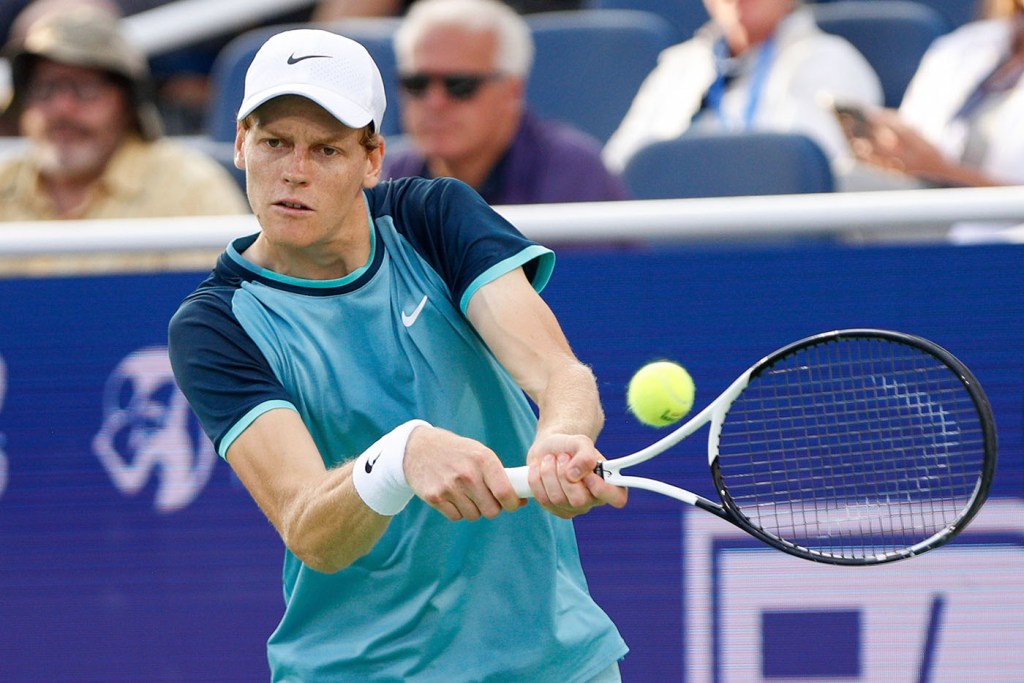Should tennis star Jannik Sinner have been suspended for two positive doping tests?
In a world where there are ample legitimate methods that could give a player a competitive advantage, it’s often the doping rules themselves that are the source of controversy, says Rory Smead, a Northeastern professor.

The tennis world is buzzing with controversy this week after it was revealed that Jannik Sinner, the men’s top-ranked player, twice tested positive for a banned substance this year — but wasn’t suspended.
Fresh off his win at the Cincinnati Open, Sinner took to social media to say that in April authorities found trace amounts of clostebol, an anabolic steroid that can be found in some over-the-counter ointments and sprays in some countries, in his blood after an episode of “inadvertent contamination.”
After an extensive investigation, the International Tennis Integrity Agency (ITIA) accepted the 23-year-old Italian’s explanation, saying he wasn’t at fault and thus allowed him to continue playing — though he had to fork over $325,000 in prize money and some 400 ranking points as a result of the positive tests.
An independent panel of experts echoed the ITIA’s findings, noting that the trace amounts of the drug (less than a billionth of a gram) “would not have had … any relevant doping, or performance-enhancing effect upon the player.”

A source of controversy
As there have been doping suspensions in tennis in recent years, outrage over the situation was expected — particularly as the investigation took place behind the scenes without the public’s knowledge.
But in a world where there are ample legal methods that could give a player a competitive advantage, it’s often the doping rules themselves that are the source of controversy, says Rory Smead, associate professor of philosophy and the Ronald L. and Linda A. Rossetti Professor for the Humanities at Northeastern University, who teaches ethics and philosophy through sport.
From dietary supplements, pain-killing injections and carb-loading to medical interventions or just watching an opponent practice, Smead points to a variety of legitimate means by which players can get a leg up in sporting competition.
“Some studies show that even caffeine gives you moderate performance-enhancing effects in certain minor ways,” Smead says.
Smead says that the doping discourse touches on questions of moral philosophy. If doping weren’t against the rules, would it be morally wrong in the first place? Should doping rules be viewed as an extension of the sport itself — as rules within, rather than about, the game?
“When you start really pressing on these things, it generates a lot of questions that there aren’t any obvious answers to,” Smead says.
Certain performance-enhancing drugs, such as anabolic steroids, can give athletes an edge because they may help build muscle and increase strength, according to the Mayo Clinic.
Other anabolic agents, such as human growth hormones, may not necessarily lead to improved performance. Both steroids and human growth hormones carry serious health risks as well, and are prohibited by the World Anti-Doping Agency.
Featured Posts
Double standards
The news of Sinner’s positive tests split players and commentators over how anti-doping authorities handle cases involving high-profile athletes compared to lesser-known athletes.
“Ridiculous — whether it was accidental or planned. You get tested twice with a banned (steroid) substance… you should be gone for 2 years. Your performance was enhanced. Massage cream…. Yeah nice,” wrote Nick Kyrgrios, a 2022 Wimbledon finalist.
International Tennis Integrity Agency rules stipulate that a player who tests positive for a banned substance is subject to a “mandatory provisional suspension.” The rules let athletes appeal the findings, but a suspension is usually triggered regardless — at least, that was the case with a handful of other male and female tennis players.
“Can’t imagine what every other player that got banned for contaminated substances is feeling right now,” wrote tennis pro Denis Shapovalov. “Different rules for different players.”
In a press conference at the U.S. Open this week, Sinner said that he was, in fact, suspended for several days, noting that he couldn’t practice but that the ITIA was quick to process his team’s appeal. “They accepted it really fast,” he said.
Negative stigma attached to players
The negative stigma that attaches to players who are perceived to be doping may incentivize anti-doping agencies to handle cases involving famous athletes with greater care, Smead says. Even so, a lot is unknown about the process.
“The way a lot of these professional organizations handle these incidents is they have these discussions behind closed doors,” Smead says. “We actually don’t know a whole lot about how these decisions are made.”
Smead says he can see where both the critics and supporters are coming from, but added that doping violations shouldn’t be viewed “as some great moral wrongdoing.”
“Athletes are in their spotlight and they are held up as role models, whether they want to be or not,” Smead says. “And part of what athletics is all about is displaying excellence … and excellence isn’t just about your performance on the field, but the lifestyle you followed that got you there.”











